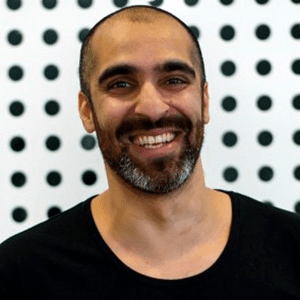

#37: Wearing all the hats with an innovation mindset
CEOs and Founders are often responsible for wearing many hats in their organisation. It can be tough to find the right balance, especially when trying to focus on an innovation mindset. Ben Grozier, Co-Founder and CEO of Classcover, shares his tech start-up story and the insights that helped him pinpoint what his business needed to succeed. Here a few of his insights:
- It is crucial to build a culture where your people are empowered to say:
- I was wrong
- I made a mistake
- I need help
- It is my role as CEO, to create intentional context for the company, my team and our stakeholders
- The key to remaining nimble is reducing barriers and creating a frictionless business
Ben discusses the importance of an innovation mindset and how understanding problems from a customer’s perspective is the key to finding the right solutions. He also talks about how ‘First Principle Thinking’ has allowed his organisation to speed up their pathways to success by stripping down problems, removing vanity metrics and finding unbiased solutions that deliver real value.
Stephanie: Hello, and welcome to TEC Live. Stephanie Christopher here, chief executive of The Executive Connection. TEC connects CEOs, executives, and business owners to the world’s largest business leader network.
Leah: It’s always a great day when TEC Live releases new podcasts because you know you’re going to hear a lot of new ideas that you can then either listen back to or have a think about. So, I get to hear it live live. I’m sitting in the studio with Stephanie, and I’m going to get all the ideas. Hi Stephanie.
Stephanie: Hi Leah. That’s great. What an intro? Well, I’m glad we are live and you seem very much alive today.
Leah: Very much.
Stephanie: Cool. Well, I’m really excited to introduce our guest today, Ben Grozier, the Co-founder and CEO of Class Cover. A software, as a service organisation that helps over 2000 schools in Australia, New Zealand and Singapore to save time in the management of their casual relief staff. Ben describes his working life as being divided into three parts, teacher, small business owner and tech start-up founder. Using this experience, he loves educating business owners to avoid the mistakes that he’s made, to achieve their goals faster and cheaper. Ben Grozier, welcome to TEC Live.
Ben: Hi Steph. Good to be here.
Stephanie: I think you sound like David Brent.
Ben: I’d never thought of that. There was always the Mr. G comparison with… I can remember Summer Heights High when I was a teacher back in the day someone dropped a Mr. G mug on my desk one day. I thought it was half funny.
Stephanie: But yeah, yeah. That’s more what I want… No, I think I take David Brent. I’m probably more David Brent, you can be Mr. G, this is going to be a good conversation.
We’re going to talk today about the different hats that a business owner or indeed a CEO has to wear, and tell us… Well, first of all, tell us about Class Cover because it’s an interesting organisation. Tell us about that.
Ben: Yeah. I mean, as you say, Class Cover, as a software as a service, help schools manage their casual teachers, and it was really a classic solution to a problem scenario. That was to say that back in 2011, I was actively teaching. I’d come back from five years, six years in the UK, and I’d just gotten out of the surf. Funnily enough, it was the middle of August, pouring rain, peak time for casual teachers.
I got a call from a teacher at Harwood Public School, and she said, ‘Can you come in to work?’ And, I said, ‘Yeah, no worries at all. See you in half an hour,’ then I got another call from a teacher at Harwood Public School and I said, ‘Can you come in and work?’ And I said, ‘No, I’m already teaching for Tony.’ And then, I got another call from a teacher at Harwood Public School and I was just like, this can’t be right. There can’t be such little amounts of collaboration, and if one teacher, one booking is experiencing this, what are 2,300 schools across New South Wales, 9,900 across Australia what are they experiencing? We estimated about 4 million wasted phone calls are being made every year to unavailable casual teachers.
Stephanie: Goodness.
Ben: And-
Stephanie: So, does a teacher, normally, would that be how it would work? A teacher would find a casual teacher.
Ben: Yeah. Yeah. That’s one way that schools approach it so everyone covers their own absences, or it might just be a principal who’s responsible for everybody at the school-
Stephanie: Which is even worse.
Ben: … yeah, and they might be making up to 12 teacher bookings a day, taking two hours a day on the process. So, I mean, pretty much we’ve plagiarised wotif.com, I don’t know if you remember the hotel booking app from-
Stephanie: When we used to go to hotels, I do remember that.
Ben: Yeah. Yeah. Exactly. That’s about right. They got acquired by Expedia, I think, and I always thought it was a shame when they lost that matrix of availability. But, that’s exactly what we plagiarised. It was the hotel names down one column, and then the dates across the other.
Stephanie: Yeah, that’s right.
Ben: It wasn’t a hundred percent bulletproof, but you could go and see your teacher’s availability in advance of calling them. And, even to this day, first out of school holidays today, but up until last week, we could go on a school’s list and I’d have a hundred casual teachers and literally 90 of them would be unavailable on any given day. And so, you can imagine what problem that was solving when it came to better targeting teachers who could and wanted to work.
And so, that was the basic premise of the platform and then we went on the rollercoaster. Yeah, and just… I was talking to someone yesterday who was looking to start a business and talking about the risk involved and what have you, and I said, ‘Look, twice as much time, three times the money.’ And, it’s a good little rule of thumb usually when starting something up.
Stephanie: So, it’s going to take twice as long as you think it will, and it’s going to cost three times.
Ben: There or thereabouts, and-
Stephanie: Easy.
Ben: … I think most business owners would reflect, and especially those who have started something from scratch, would reflect and say that at the very least you need to put in that level of buffer. And so, we went down that pathway and we built something out very light, and then we just tried to get schools to give it a go. It was all a PowerPoint slide deck to start with was absolutely manual, backed by a good story, and I’m trying to get our leveraged contacts, trying to get people just to take a chance on us. And then, build it out and then grow it from there.
Stephanie: It’s great.
Ben: Yeah.
Stephanie: Great story. Is that your first startup? Was that your first startup?
Ben: Yeah. Yeah, first tech startup.
Stephanie: Yeah.
Ben: We had a small professional development company prior to that. I’ve got a bit of a sport background. I was a tennis coach for 10 years. I ran tennis centers in Australia and the UK and-
Stephanie: Totally. Mr. G.
Ben: Exactly. And so, we saw there was a real gap for teaching PE teachers how to teach or training them. You could always go and get literacy and numeracy professional development, but there was real gap for PE.
Stephanie: Yeah, right.
Ben: And so, we did that. It was more that, that was on the sides, I guess, and we never really threw down to go full time. But, I think it was a problem we were solving, it just probably wasn’t the time. And, this is an important consideration. I say to many people, especially people who are little wary of their ideas being stolen. And, that’s the case that there are so many good ideas out there. Execution is the main component to getting an idea to turn into reality. But then, also people’s lives and people’s time often just doesn’t blend in well.
I was fortunate enough that I was just in a stage of life when the idea came to me. I had a low commitment job as a casual teacher, I was in between the UK and Australia just re-establishing myself here, and it was the right time to execute.
Stephanie: There’s so much there to unpack all of that. So, let’s get to the idea of the number of hats that you have to wear.
Ben: Yeah.
Stephanie: Where you are in your business right now, tell us about the number of hats you have to wear?
Ben: Yeah so, at the moment, we’re a team of about 22. Everyone in our team is reasonably well divided into different roles. The way I see my role, as running Class Cover, is someone who just tries to give context to start with, because I’m the only one in the business who’s been there from go to woe. And, it’s amazing how often that comes up. I might be talking about a feature or I might be talking about a customer, I might be talking about one of the governing bodies that we work with. And also, I’m the only teacher on the team, and that hasn’t always been the case, but as it stands I’m the only qualified teacher. And so, we’re in a HR business, but we’re also an education business. We work in education so giving context is a big part of what I find myself doing at the moment.
But then, also just reducing barriers and trying to make things frictionless. And, I’m such a big believer that the best functioning teams… I do sincerely believe that you could drop the Class Cover team in its current form into any small to medium tech business, and they would thrive based on mindset. They’re a brilliant team and I think a lot of that comes down to I think myself. I’ll give myself a little bit of credit for this, building a culture where no one feels any reservations about saying these three things and that is, I’m wrong, I need help or I made a mistake. If you can get a team around you who are not hiding from those three things, but feel very comfortable in the knowledge that if I come to you, as soon as I’ve got a question, I’ve made a mistake, I need help, then we’re going to speed up the pathway to success, and it’s going to be more frictionless. That’s the mindset I taped the entire operation of the company. How can we be more frictionless in relation to where we want to go?
And, I’m the one that can either create, because I could put huge bottlenecks if I wanted to have decision-making power over everything we do in the business. We still run pretty lean, 2000 schools, 50,000 casual teachers, team of 20, that’s a team in Chennai, team in Seville in the Philippines. Things could be very slow, but we try to make decisions on the available information, not overanalyze too much, fail fast, fail cheap but, again, this is all with the overarching theme of trying to be as frictionless as possible.
Stephanie: I really love the two things that you’ve said there. The first one is creating context. That’s actually the role of a leader in the business anyways.
Ben: Yeah.
Stephanie: Especially someone who’s been there more than five minutes.
Ben: Mm-hmm (affirmative).
Stephanie: But, the creating context has to not be we tried that before and it didn’t work so we won’t do it, but it’s being very intentional about what information will help you in the decision you’re making now, understanding either the context of my vision as the leader or the context of the history of the organisation. I think that, that relates to every single business leader, and then the other one is that frictionless, taking away the barriers.
Ben: Mm-hmm (affirmative).
Stephanie: Boy, that’s hard for organisations, isn’t it?
Ben: It is and it’s funny because I feel like that in start-up, there’s a real contradiction in start-up. I do a lot of work with regional start-ups, and I find them to be so refreshing to work with, because I think they come to the table with no adherence to stereotype. They look at things again, talk about First Principles Thinking, they look at what’s the problem I need to solve and I solve it. They don’t look around and go, what’s everyone else doing? How do I get on the front page of the financial review? They bring a way more greater clarity to their plans around executing on their solutions.
Stephanie: Can you say more about First, I can’t even say it, First Principles Thinking?
Ben: First Principles Thinking.
Stephanie: Yeah.
Ben: Yeah so, First Principles Thinking is just not living or working by analogy, and the vast majority of people they live by analogy. That is, they look around, they see how everyone else is solving problems and they go, ‘Well, that’s how I need to solve problems.’ It’s not stripping it down to, ‘What’s the actual problem here and what’s the solution? What do I need to actually achieve, and how do I achieve it?’ And, there’s a really good sporting example of that, that’s been in the news just recently. I don’t know if you like your golf at all, Steph, but-
Stephanie: No. No. I’m completely neutral so you teach me something.
Ben: Well, and it’s not about loving the game or not, but interestingly and I actually don’t… I like the game and I follow the game so closely that I even know the name of this guy, but he won the US Open. And, he brought this completely different approach to getting the ball from the tee into the hole, which is what you need to do in golf. You need to get the ball from the tee to the hole in as few shots as possible. What he decided to do, when the pandemic came to pass, number one, he had a physics major and so he explored golf club technology. He explored all the dynamics around golf ball flight what have you, and then he hit the gym.
He came up with this theory that if he can hit the ball 50, 60 meters, further past anyone, further than anyone else in the game, then to be able to hit a shot, maybe from the rough, from a less than ideal position from 50 meters away was way better than hitting it from 150 meters away in the perfect position, If you know what I’m saying. All the establishment went, what the hell is this guy doing? This big muscly bloke he’s just belting the cover off the ball, he doesn’t care about where it lands, but he won the tournament by six shots.
And, I thought it was a great example of First Principles Thinking, because he just came at it. I need to do this, I’m going to analyze it, I’m going to work at how to best do it. And, he didn’t listen to all these naysayers are running, that’s not how you play golf. You keep it straight and true, and you get the ball from here, to here, to here in this way. It was a really good example there.
Stephanie: So then, that’s truly disruption, isn’t it? You’re forgetting about analogies, you’re forgetting about… You’re just starting from scratch.
Ben: That’s right. I guess back to the point about whether it be the regional start-ups or the start-ups in general, I find that we talk about ourselves being innovators with our products and services, but I actually think, especially in a lot of the metropolitan cities, I feel like there is a real lack of mindset innovation. That is to say, okay, what’s a success metric for a tech start-up? Is it to get on the front page of the Financial Review to announce a capital raise, to tell your mates how many people you just hired. I think there’s a complete lack of respect for being cashflow positive or for being profitable. The vanity metrics overtake the actual metrics of value.
Stephanie: Yeah, and so mindset innovation, where does that fit in?
Ben: Well I think, again, it’s looking at the problems on their merit and saying, how do we solve it? I mean, let’s say from a Class Cover example. Our average invoice size is about a thousand dollars per school per year.
Stephanie: Yep. Right, okay.
Ben: That wasn’t always the way. We were priced a lot lower. I always talk with start-ups about making sure that you are blending your life into your business model. Now, my life situation didn’t allow me to wait around for three years until a school was willing to pay a thousand dollars per year for Class Cover. We needed revenue ASAP so we priced quite low. A gentleman called Peter Thiel, who was a Co-founder of PayPal, extremely successful investor, he talks about the software as a service, a valley of death.
Stephanie: Oh, yes. I’ve heard you talk about this before. I’ve heard you often being quoted. So, tell us about the SAS valley of death.
Ben: The SAS valley of death. He puts forward that the SAS company has a very hard time surviving if their price point sits somewhere between a hundred dollars per year and a thousand dollars per year. And, that’s because that under a hundred dollars a year, people will typically make impulsive decisions-
Stephanie: Won’t even think about it.
Ben: … need no coercion.
Stephanie: Mm-hmm (affirmative)
Ben: Above a thousand, you can afford a sales team, but in between that there is too much impediment in the way of price point to make that impulsive decision, but then you can’t afford a sales team. We found ourselves smack bang in the middle of the SAS valley of death. We’re charging probably $600 per school per year on average, and so from a First Principles point of view, and not to say this is anything revolutionary because lots of people do it, but we dropped our cost of acquisition for school’s Class Cover by engaging with Still, our excellent team in Seville in the Philippines. My Co-founder and I would go to principal’s conferences, drum up interest, and then the guys in the Philippines would call through and book demos and get free trials, and it allowed us to survive in that SAS valley of death zone, while a lot of people around us were saying, ‘Oh, no. You’ll never survive.’
But, it’s just innovate your mindset. Just, just… The world is so full of opportunities to pull levers in relation to operating cost or logistics and that’s what we did. And then, obviously gradually we lifted that price up, but we still follow the same model today, except we don’t go to principal’s conferences anymore because there’s a pandemic.
Stephanie: Yeah, that’s right.
Ben: Yeah.
Stephanie: Really interesting. All right, so I’ve got a question with that. I’m hearing people saying now it’s really hard to sell. You can’t acquire new customers because you can only do that face-to-face. And, I questioned that from a First Principles point of view, but what’s your view of that kind of thinking?
Ben: I think it depends because obviously relationships and rapport form a huge part of the sales process. I think, again, I think it’s something that people underestimated, but in education, especially in what I call a compassionate industry, people purchase on emotion. And so, I think there is some validity to there being there are greater challenges, but maybe it’s just an adjustment, and that adjustment is because people had that expectation.
And, we say, it’s funny, I think it’s a really New South Wales thing, having sold Class Cover all around the country, where everyone in New South Wales wants to be your mate before they buy, whereas in other states in Australia, what I’ve noticed, is a greater pragmatism.
Stephanie: Even in Queensland?
Ben: It’s funny, you say that actually, because we have an enterprise contract in Queensland, but we don’t have any school-to-school sales for the reason… Anyway, not worth going into, but so we haven’t actually tested it there, interestingly.
But, in relation to the face-to-face component is gone, Is it more difficult? I think like everything we’ve in the last eight months or so, it’s a new challenge. But, I mentioned before we came on air that we’ve got this agreement to deliver online tutoring for a big Australian charity who I can’t name at the moment, and it’s 6,000 hours of cheering for underprivileged kids, really excited about it.
Stephanie: It’s wonderful. Fantastic project.
Ben: I literally saw the project manager for the first time today on a Zoom call, it had been phone and email, and we were amazed at when we got on the Zoom call, I can’t believe we haven’t even seen each other on a video call. I think the world has adjusted, and it’s a bit like this. You’re not going to be able to run a functioning company unless everyone’s in the office five days a week.
Stephanie: Yeah.
Ben: Once the hand was forced, by virtue of coronavirus, we were then almost forced to test alternative methods to work remotely, or to sell remotely, or to conduct events remotely. Some might not work as well, others take an adjustment period, some may work better.
Stephanie: You and I are doing an event together at some point in the next week or so, it’ll be brilliant.
Ben: We are.
Stephanie: It’s remote, and it’ll be amazing.
Ben: That’s right. Yeah.
Stephanie: So, now is the time, I think, for when business leaders are thinking about work, about how to engage the teams and where and what does it look like? This is a great time to have no analogies, I think.
Ben: Agreed.
Stephanie: This is a great time for thinking, what is it we want to achieve? What do we want our teams to be doing? What did they want to be doing? How else could we be doing it that’s different from what anyone’s ever thought before?
Ben: Absolutely.
Stephanie: And, what a great gift we all have, as business leaders, to be able to do this.
Ben: Agree. I think, I honestly I would refer to it as forced evolution, in a way. There’s been a lot of people making excuses for not changing, when the answer has been, is the two hour commute, is that investment of time is it worth the return? And, probably where it settles is somewhere in between. Is the return on investment of commuting two hours to go see your team sometimes, it’s probably worth it. Is it worth 10 hours of commuting a week? Probably not for most organisations. So, it’s that forced evolution of thinking.
Stephanie: I really like that. It’s a great way to look at it. What other hats do you have to wear as a business owner?
Ben: Yeah so, I mean really the finance side of things, the marketing, I mean, we have basically obviously a product. It’s with the finance, the marketing, the enterprise sales. And again, we’re in that stage where, I mean, now I find my time educating other start-up founders about how to be in that scramble, and how to wear those hats where again, you might start your day designing a marketing flyer, you might do some bug testing if you’re in technology, you might make 10 sales phone calls. And, it’s an amazing juggle. It’s a great and really energizing environment to be in for the person who is endlessly curious and wants to try and improve themselves across all areas.
And, really in order to keep those hats on, I guess, it’s important that you’re very, very aware of what you’re good at and what you like doing, and not neglecting what you’re not good at and what you don’t like doing. And there’s a whole bunch of strategies that you can use in order to make sure that you’re still giving equal amounts of love across your entire business, despite the fact that your capability set or your passions might not lie in something like finance, for example, or making sales calls. Yeah.
Stephanie: So, how do you manage the balance then of stepping back at the right time, delegating or bringing in an expert who compliments your skillset, but still being around the whole business as the founder of a start-up?
Ben: I mean, I’ve just found this brilliant little hack, and it’s a little technology hack. And, that is that I have 22 bookmarks, would you believe, saved in one folder on my Chrome browser.
Stephanie: Right.
Ben: I right click, so I open all 22 and I start my day with 22 tabs open.
Stephanie: Right.
Ben: What those 22 tabs represent is the Class Cover pulse, basically. I’ve got dashboards on sales, I’ve got dashboards on product, where’s the latest sprint up to? I can see ticket sales for our relief teacher conference, I can see where our customer success team, what they’re working on in relation to trying to make our customers more successful. 90% of those tabs will be closed in 20 minutes. Because it’s a quick check-in, it reduces questions that I need to ask my team so I can focus on more strategic things or questions that matter. That’s a really tangible way of keeping all those balls in the air. And yeah, I mean, in relation to knowing how to balance and what to focus on, I just always try to be really mindful of highest impact, lowest effort. If it’s a lot of effort, it better be high impact. And again, because we all are susceptible to drifting.
Stephanie: Yes.
Ben: Yeah. Some people, and I see this all the time, product guys who don’t want to sell, and-
Stephanie: They just want to keep, it’s ready I’ll just change it, change it, change it.
Ben: That’s right. Exactly right.
Stephanie: I can improve it a bit more. And yeah, I’ll have another look…
Ben: Yeah, and that could include some founder pride as well. We see that all the time, where they hold on tight, not now, not now, not now and then they let it out but this, if you build it, they will come, mindset is really problematic with a lot of start-ups because building a product is fun. It’s great. It’s your baby. You’re probably solving problems but, ultimately, you should be a slave to your customer and they should be dictating your roadmap, whether it be, again, a tech product or a regular product or service-
Stephanie: It’s absolutely whose problem are you solving-
Ben: Exactly right.
Stephanie: … and how do they want that solved?
Ben: That’s right.
Stephanie: What are your top tips for someone considering a start-up?
Ben: So, first and foremost, I would say you want to identify a big problem with a big solution in a big market. For Australian start-ups, that actually presents a challenge because I think it’s, again I don’t want to be critical of the Australian start-up ecosystem, but at the same time, by virtue of us having quite a small market, we do see quite a few what I would call non-problems being solved.
Stephanie: Yeah. A solution, looking for a problem.
Ben: Yeah, exactly.
Stephanie: Yeah
Ben: And, it’s because… And look, I think, start-ups not trendy. It went through a period of being trendy, but start-ups are here to stay. It’s so cost-effective to start a business now, with all the tools at our disposal, that it’s not going away. But, at the same time, a lot of people love the entrepreneur dream, they don’t have the big solution to go with a big problem so they try to reverse engineer a problem or a solution in fact, and that can be tricky. If you’re in a market of 310 million people in the US, you can solve non-problems and still get critical mass. In Australia, it’s a different kettle of fish, and so for people wanting to go down this start-up route, you need to ask yourself, is this a problem we’re solving?
And, for me, it comes back to what I’d call a sleep test for me personally. And then, just like yourself and just like so many other people you’ll have all ideas going through your mind all the time. Now, probably about 90% of them don’t survive one sleep for me. I’ll wake up three in the morning go, ‘Oh no, that won’t work.’ And then, a few of them, we’ll get through four or five nights of sleep, and inevitably I’ll wake up and go, ‘Oh, bugger. Didn’t think of that.’ And then, with Class Cover, eight years on, I bottom of my heart, still get out of bed in the morning and think, this is a problem we’re solving. If we don’t solve this problem, some senior executive at a school is going to have to go back to making-
Stephanie: All those phone calls.
Ben: … two and half hours’ worth of phone calls.
And, just an extension on that big problem, big solution, big market, when you’re asking other people their opinions on your problem and solution, don’t ask your family and friends because they love you way too much. And, you want to get a diversity of feedback because even people who are not family and friends, because, and I think this is partly cultural as well, they don’t want to let you down. They don’t want to be negative. They’ll say, ‘Oh, yeah. I’ll buy your product,’ and then ask them to write a check.
It’s so often people just don’t want to hurt feelings, and so getting that excellent early stage feedback to make those first crucial decisions as to you got 40,000 hard earned dollars in the bank, and you want to get a version one product out, you need to ask those big questions about problem and solution, before you go down that path of actually deploying any of those funds.
Stephanie: Spending some money.
Ben: Yeah.
Stephanie: Boy, out of all of this, some wonderful tips at the end about what really a start-up is, and I’ve heard from you so much, it’s about the problem from the customer’s point of view. And, with Class Cover, you’re really clear on who the customer was.
Ben: Mm-hmm (affirmative). Absolutely.
Stephanie: And, it’s a platform so you’ve built out an ecosystem of all different customers, ultimately, but that’s really interesting. And, I think the points you’ve made about the hats that a founder, owner wears where the hats they wear, as well as the hats that any CEO of any business wears. And, that’s about, I love that context. That one’s really good. I’m going to think about that a lot and removing the barriers. And then, when you talk about the kind of culture that you have with remote teams, there’s been a lot to think about here, Ben, and thank you so much for joining us today.
Ben: That’s my absolute pleasure. Thanks for having me.
Stephanie: Thank you. So, that’s TEC Live for today. CEOs are in the business of making decisions, and leadership is the art of execution. I’m Stephanie Christopher, and look forward to talking to you next time.



